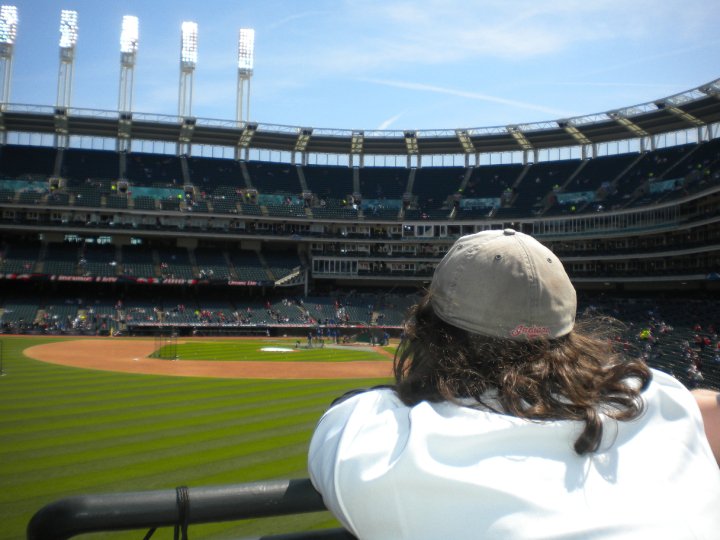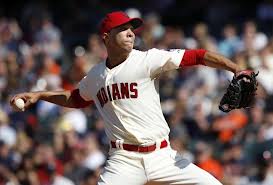 Indians Archive
Indians Archive  View from the Porch: A Report on Pitchers and Catchers
View from the Porch: A Report on Pitchers and Catchers
 Pitchers and catchers report to Spring Training in Goodyear, AZ on Sunday and these two groups will be the keys for the Indians this season. The starting rotation has to be the chief concern, for both the Indians and for the fans, and the catchers will be called upon to help navigate troubled waters. The rest of the team must report by February 16 and Spring Training games begin February 22.
Pitchers and catchers report to Spring Training in Goodyear, AZ on Sunday and these two groups will be the keys for the Indians this season. The starting rotation has to be the chief concern, for both the Indians and for the fans, and the catchers will be called upon to help navigate troubled waters. The rest of the team must report by February 16 and Spring Training games begin February 22.
The Indians will go as far as their pitching staff takes them. The offense should be at or above league average, so the pitching staff will have to be good. I won’t go so far as to say that new pitching coach Mickey Callaway has to be a miracle worker, but there’s no question that some guys absolutely need to be better than they were in 2012. The good news about the rotation this season is that the Indians have some better depth for the fourth and fifth spots, even with Josh Tomlin’s Tommy John surgery and Carlos Carrasco’s return from missing a season due to Tommy John surgery.
The locks for the rotation, much to the chagrin of some people, are Justin Masterson, Ubaldo Jimenez, and Brett Myers. If Trevor Bauer makes the ballclub, which I would generously set 50/50 odds on, he’s obviously in the rotation. The battle for the fourth and fifth spots includes Bauer, Zach McAllister, Corey Kluber, Scott Kazmir, and on the far reaches of that group is David Huff.

Because this is going to be the theme of this week’s View from the Porch, I’m going to start with Scott Kazmir. Initially, after the Kazmir signing was announced, I put him in the David Huff category of a real long shot to make the rotation and thought very little of it. Between now and then, something changed. Kazmir is best remembered for his recent seasons, a couple of ghastly performances in 2009 and 2010. Over those two seasons, Kazmir was 19-24, with a 5.41 ERA, a 5.05 FIP, a 6.36 K/9, and a 4.2 BB/9.
Remember that FIP is a better indicator than ERA of runs allowed that pitchers are responsible for. The acronym FIP stands for fielder independent pitching. It takes defense out of the equation and focuses on what a pitcher can control: home runs allowed, walks, hit batters, and strikeouts. None of those numbers scream “ROTATION CANDIDATE”, even for the Indians.
The caveat here is that Kazmir was a very good pitcher once upon a time. From 2005-2008, Kazmir was 45-34, with a 3.51 ERA, a 3.72 FIP, a 9.68 K/9, and a 4.06 BB/9. Kazmir’s 3.72 FIP from 2005-2008 would rank 17th (out of 84) among pitchers with at least 500 innings pitched during that span.
So, what happened to Scott Kazmir? The obvious point to make is that he stopped missing bats. From 2005-2008, his swinging strike percentages by year were 10.9, 12.5, 12.1, 11.8. In 2009 and 2010, that percentage dropped to 8.7 and 7.4. He was also sent to the disabled list with “shoulder fatigue” in 2010. It got so bad for Kazmir that he pitched just 17 innings for the Angels organization in 2011, walking 22 batters and looking like a pitcher whose career was done.
Kazmir spent the 2012 season with the Sugar Land Skeeters in the Atlantic League. During Kazmir’s first full Major League season in 2005, his average fastball velocity was 92.6 mph. By 2009, it was down to 91.1. By 2011, he couldn’t even touch 90, averaging 86.5 mph.
About four years ago, I ran into some work done by an old grade school acquaintance of mine, Kyle Boddy. Boddy runs a Seattle-based baseball academy called Driveline Baseball, which specializes in player training through teaching proper technique and strength training, based on years of research in biomechanics and kinesiology. In other words, very advanced, high-tech stuff.
Along with Boddy’s work at his facility, he also contributes to various baseball blogs and websites, including The Hardball Times. A couple of days ago, he linked his latest article for THT about finding risk-free wins. Growing up in the Cleveland area, Boddy still has an affinity for the Indians, so this piece was probably inspired a little bit by the Kazmir signing. The premise of the article is that organizations choose to get rid of pitchers with declining, or below average, velocity rather than attempt to restore/increase their velocity through training programs designed to build velocity. Coincidentally, one of the hallmarks of Driveline Baseball is in the field of developing velocity and arm strength for pitchers, so Boddy knows that it is both possible and easy to attempt. Not necessarily easy to achieve, but at least easy to attempt. It's one of those "What do you have to lose?" scenarios.
In bantering back and forth on Twitter with Boddy after reading the article, his exact words to me were, “Just wait until you see Kazmir throw for the Indians. I think you’ll be surprised.” He told me that he knows Kazmir’s offseason trainer, which supports the Jon Heyman tweet back on December 4 that Kazmir was throwing 90-94 in the Puerto Rican Winter League.
The Indians are taking a low-risk gamble on a guy who has put in a lot of work to try and rectify his career. It’s extremely admirable on Kazmir’s part and it makes him an easy guy to root for. The Indians are hoping to get value out of Kazmir and he deserves to find success. Hopefully that success comes in Cleveland.
Which brings me to my next point: In the article linked above, Boddy linked another of his articles, a fascinating piece from last May that looked at the sabermetric value of increasing fastball velocity. If you’re a regular reader of this column, you know that I have delved deeper and deeper into sabermetrics and have tried to get a better understanding of the concepts and stats. With so many baseball front offices shifting from the old way of player evaluation and into the new, the Indians being one of the teams at the forefront of that shift, having an understanding of sabermetrics and player value makes understanding the way teams do business a little bit easier.
Boddy calls his article “educated guesswork”, which is accurate, as his sources are not infallible, but they are well thought out and well-researched. The article takes a pitcher whose fastball velocity was 90 mph in college and has now dropped to 86 mph in the Majors. He is looking at a demotion, or possibly even being released, if he does not start to perform better. The solution, in Boddy’s mind, is to restore the pitcher’s velocity. Without restating the article, Boddy takes a pitcher, based on a real life starter who is no longer in baseball, and gives him a fictional stat line.
The stat line is as follows: 24 GS, 255 FB, 28 HR (11% HR/FB), 50 BB, 2 IBB, 7 HBP, 120 K (7.2 K/9), 150 IP (6.25 IP/start) - 5.02 FIP.
The sources in the article address how added velocity can lower home runs per fly ball (HR/FB) rate, increase strikeouts (K/9), and induce more ground balls (GB%). Even without looking at the numbers, these are all reasonable conclusions to make about increased velocity. The faster a pitch is, the less reaction time a hitter has. The faster a pitch is, the harder it is to get the barrel of the bat on. When hitters are late on pitches, they tend to hit only a portion of the ball, which either induces a pop up (lower HR/FB) or a ground ball (lower fly ball rate), or they miss it altogether.
Using the sources, Boddy hypothesizes that this particular pitcher increasing his velocity by 4 mph would have this stat line: 24 GS, 230 FB, 24 HR (10.34% HR/FB), 50 BB, 2 IBB, 7 HBP, 141 K (8.464 K/9), 150 IP (6.25 IP/start) – 4.39 FIP. That is a 12.5 percent improvement from the previous stat line. Using FIP, WAR (wins above replacement player), and the relationship between dollar value and WAR, Boddy’s hypothetical pitcher produced $6.04M more in value, simply by restoring his velocity, not to mention, was worth about 1.2 more wins above replacement player than in his previous stat line.
Why is this relevant? Because an experiment like this could be incredibly beneficial to the Indians. As a small-market team, the Indians need to find value wherever they can get it. The Kazmir signing is one example of the Indians trying to take advantage of a pitcher creating value and making himself an attractive low-risk, high-reward signing.
 Ultimately, this brings me to Ubaldo Jimenez. Jimenez is a pitcher that the Indians paid a steep price for and has yielded very few positive results. There’s a lot to be concerned about with Jimenez and the 2012 season illuminated all of those things. To go along with looking awful to the naked eye, the statistics tell a sad story, full of despair and disappointment.
Ultimately, this brings me to Ubaldo Jimenez. Jimenez is a pitcher that the Indians paid a steep price for and has yielded very few positive results. There’s a lot to be concerned about with Jimenez and the 2012 season illuminated all of those things. To go along with looking awful to the naked eye, the statistics tell a sad story, full of despair and disappointment.
Since I like using numbers, I’ll at least put them in an easy-to-read chart to illustrate Jimenez’s downward trends.
|
|
2008 |
2010 |
2011 (CLE) |
2012 |
|
Avg fastball velo (mph) |
94.9 |
96.1 |
93.5 |
92.5 |
|
Groundball rate |
54.4% |
48.4% |
47.5% |
38.4% |
|
HR/FB% |
6.9% |
5.1% |
10.0% |
11.8% |
|
FIP |
3.83 |
3.10 |
3.81 |
5.06 |
|
K/9 |
7.79 |
8.69 |
8.54 |
7.28 |
|
BB/9 |
4.67 |
3.74 |
3.72 |
4.84 |
|
Swinging strike % |
8.9% |
9.1% |
7.3% |
7.0% |
Right in line with what the sources from Boddy’s sabermetric value of increased velocity article found, Jimenez’s lower velocity has led to an increase in home runs allowed, a drop in ground ball rate, and fewer strikeouts. Command is, and has always been, an issue for Jimenez, but the bigger issue is that his lowered velocity has created a smaller margin for error. While the Indians have tried mechanic fixes and have paid extra attention to Jimenez, the root of the problem may be simpler than they think. It probably wouldn’t be a cure-all by any means, but restoring Jimenez’s velocity through a strict training regimen would be a good starting point.
Consider this. Though the Pitch F/X values at Fangraphs are not an exact science, as the Pitch F/X system occasionally classifies pitches incorrectly, Jimenez’s fastballs in 2009 were worth 10.8 runs above an average pitcher’s fastball. In 2010, the best season of his career, his fastballs were worth 26.5 runs above an average pitcher’s fastball, which was the second-best of any pitcher in Major League Baseball. In 2012, Jimenez’s fastballs were worth -19 runs below an average pitcher’s fastball. That was the sixth-lowest mark out of 111 pitchers who threw at least 130 innings last season.
There’s a psychological element in this as well. Jimenez, who didn’t handle the 2011 trade very well, first feeling sorry for himself for being traded from the only organization he knew, and later, holding a very public grudge against the organization, doesn’t have the confidence that he can throw the ball past anybody anymore. As a result, he uses his entire repertoire, which includes eight or more pitches. He has better command with some than others. He outthinks himself, and probably his catcher, and starts trying to outsmart hitters. So far, as the numbers show, that approach has not worked. For Jimenez, simplicity is better than complexity. Not only is trying to restore his velocity a relatively simple fix, but getting him to focus on four or five pitches rather than seven or eight should be a no brainer. Just throw what gets the best results.
Let’s assume that the Indians were able to work with Jimenez and add 2.5 mph back onto his fastball. It’s close to the 96 mph he threw back in 2010, but, at 95 mph, he would instantly become a more effective pitcher. Not only would it help his fastball statistics, but it should also create more pitch speed separation between his fastball and his assortment of breaking balls. Keep in mind, too, that this is average fastball velocity. If Jimenez is sitting 95, that means he’s occasionally running it up there at 97.
Using the factors from the article above, Jimenez could expect a .41% decline in HR/FB%, a .79 increase in K/9, and a five-to-seven percent increase in ground ball ratio. I’m being generous with the ground ball ratio since 2012 was so much different than his career numbers.
That could mean up to two less home runs allowed (which, given the amount of walks for Jimenez, could easily save as many as six runs), 15-to-17 more strikeouts per season, and more ground balls. These all seem like relatively small improvements, but you have to understand that these are a big deal for guys like Jimenez. Restored velocity or not, he’s going to walk hitters. Strikeouts don’t allow runs to score or hitters to advance. Ground balls do less damage, because they rarely go for extra bases. Fewer two and three-run home runs allow him to stay in a ballgame longer or make the offense’s job easier.
Overall, it would seem that it should be easier to add a couple miles per hour of velocity than attempt to overhaul his mechanics or just consider him a lost cause.
 I’d be remiss if I didn’t mention Justin Masterson as we look ahead to the first week of Spring Training. We’re all concerned about Masterson. The biggest problem for him last season, outside of Manny Acta hanging him out to dry during some of his starts, was an increase in walks coupled with a major spike in home runs allowed. Masterson walked 1.1 more batters per nine innings in 2012 than in 2011. To make matters worse, his HR/FB% went from 6.3 percent in 2011 to 11.4 percent in 2012.
I’d be remiss if I didn’t mention Justin Masterson as we look ahead to the first week of Spring Training. We’re all concerned about Masterson. The biggest problem for him last season, outside of Manny Acta hanging him out to dry during some of his starts, was an increase in walks coupled with a major spike in home runs allowed. Masterson walked 1.1 more batters per nine innings in 2012 than in 2011. To make matters worse, his HR/FB% went from 6.3 percent in 2011 to 11.4 percent in 2012.
The worst thing about those trends is that they are more in line with Masterson’s career numbers and less in line with 2011. In other words, 2011 appears to be the outlier in Masterson’s career. He actually struck out more hitters per nine innings last season than in 2011, inducing more swings and misses, and had a higher ground ball rate.
The increased walk total and home run rate could be attributed to a drop in velocity, which both caused Masterson’s sinker to move more, making it harder to harness, and resulted in more balls over the middle of the plate when Masterson over-adjusted. The silver lining is that Masterson was clearly hurt by the defense behind him, with a 4.93 ERA and just a 4.16 FIP. Unfortunately, the defense doesn’t appear to be a whole lot better and a 4.16 FIP is not front of the rotation quality.
Don’t worry, I didn’t forget about the catchers. While the catchers didn’t get a whole lot of help from the pitchers, there are some defensive numbers that must be improved from the team’s backstops. For instance, Indians catchers only threw out 21 percent of attempted base stealers. That was the sixth-worst mark in baseball. It’s something Vinnie Pestano alluded to in my interview with him last month, so the pitching staff is aware of the problem. Tribe catchers also allowed 67 wild pitches, the third-most in baseball.
Arguably one of the worst defensive statistics for Indians catchers was that base stealers were successful in 18 out of 19 attempts at stealing third base. Keeping runners off of third base is so critical. Rarely will a guy score from second on a fly ball like he can from third. In terms of “runner bases added”, runners taking extra bases via stolen base, passed ball, or wild pitch, the Indians allowed the fourth-most, with 275. That’s a lot of free bases. The league average was 220.
There’s no denying that the Indians pitching staff was bad last season. But, they certainly didn’t get any help from their defense. Not only did the Indians have one of baseball’s worst defenses in the field, but they were also very poor behind the plate.
As you can see, there are some big problems with this part of the team and they’re a big reason why contention seems to a bit of a stretch at this point. Spring Training won’t be enough time to work out the kinks, but, hopefully, Mickey Callaway and Terry Francona have circled these as areas that need improvement and can work on them throughout the spring and through the regular season so that they are no longer issues for the future.
- NBA Announces 2013-2014 Schedule
- Browns Ink Sharknado
- Sharknado A No-Show For Rookie Camp
- Trent Richardson Out Until Training Camp
- Browns Sign Brandon Jackson
- Carrasco Suspended Eight Games
- Browns Add to Wide Receiver Depth with David Nelson
- Browns Need to Learn from Past Draft Mistakes
- Browns Release Chris Gocong and Usama Young
- Browns Missing on Grimes Disappointing, But Not The End
The TCF Forums
- Chris Grant's first 3 drafts
Kingpin74 (Tuesday, January 21 2014 10:13 AM) - The 2014 Offseason Thread
googleeph2 (Tuesday, January 21 2014 9:36 AM) - 2015 Recruiting
furls (Tuesday, January 21 2014 6:57 AM) - Mike Brown
YahooFanChicago (Monday, January 20 2014 11:15 PM) - Movies coming out
HoodooMan (Monday, January 20 2014 9:34 PM) - 2014 Hoops Hockey Hijinx
jpd1224 (Monday, January 20 2014 4:44 PM) - 2014 Recruiting
jclvd_23 (Monday, January 20 2014 2:26 PM) - Wish List - #4 Pick
Hikohadon (Monday, January 20 2014 1:26 PM) - Official- Browns Coach Search/Rumors
OldDawg (Sunday, January 19 2014 6:48 PM) - #1 overall pick Anthony Bennett
TouchEmAllTime (Sunday, January 19 2014 1:28 PM)



